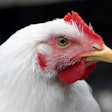
Cameras and microphones in the house could be the next big thing in poultry welfare.
Later in 2022, the Foundation for Food & Agriculture Research’s (FFAR) SMART project will help new solutions utilizing vision and audio-based technology make their commercial debut in the U.S. and Europe.
SMART
In March 2020, FFAR selected six research programs for use in the broiler industry focused on automated sensor, monitoring, analysis and reporting technologies (SMART) to receive a total of $2 million in research grants.
In June 2022, it is expected to pick two or three finalists from its initial group to receive an additional $1 million each to accelerate the development and potential commercialization of their technology. The SMART projects aim to objectively and comprehensively assess broiler welfare while improving efficiency for producers.
The six initial selections were efforts led by:
- Marian Dawkins, a professor of animal behavior at the University of Oxford, to test the ability of a novel camera and computer system called OpticFlock to monitor broiler welfare.
- Niamh O’Connell, a professor with Queen’s University Belfast, to develop a vision-based system leveraging existing human crowd surveillance algorithms and apply them to the tracking and behavior analysis of broiler chickens.
- Dr. Ingrid de Jong, a senior scientific researcher at Wageningen University & Research, to use an affordable camera-based system and artificial intelligence to automatically record broiler chicken behavior on the farm.
- Scio+, to use camera technology and advanced image analysis to continuously monitor commercial broiler flocks, map welfare assessments and estimate walking ability.
- Dr. Hao Gan, an assistant professor at the University of Tennessee Institute of Agriculture (UTIA), to use multi-angle and multi-range cameras to monitor broilers at an individual and flock level and measure their walking ability and level of activity.
- Tom Darbonne and Dr. Brandon Carroll with AudioT, to develop audio-based monitoring tools created on bird vocalizations alerting farmers to broiler welfare and behavior.
Funding assistance came from McDonalds Corp., which helped develop the program, and the U.S. Poultry & Egg Association (USPOULTRY). Dr. Denise Heard, vice president in charge of USPOULTRY’s research program, said her organization contributed $100,000 to the SMART project.

FFAR is a non-profit organization dedicated to funding research in agriculture founded by Congress in 2014. FFAR’s mission is to build public-private partnerships supporting agriculture research. The organization is funded through the federal budget and seeks funding support for researching programs from companies and organizations such as USPOULTRY.
Dr. Tim Kurt, scientific program director for FFAR, said research it supports has already led to notable improvements currently saving the dairy cattle breeding industry more than $8 million a year in feed costs. It is also working with USPOULTRY on chick sexing technologies.


The second phase
The second phase of the program will commercially validate the projects chosen from the first round for their technological progress and potential promise. Data collection in a commercial setting is essential for success.
Heard said a formal review of the research and its progress during the first two years of the program was held in January 2022. Heard and Kurt said a formal announcement of the winning teams will come in the summer of 2022.
Commercial trials could begin as early as June 2022. McDonalds Corp. will try the technologies in its U.S. and European supply chains, Kurt said.
Tyson Foods Inc., will continue its work with the emerging technologies at its research farm in Arkansas. The animal welfare research farm is led by Dr. Karen Christensen, senior director of animal wellbeing for Tyson Foods Inc.
Kurt hopes that by the end of phase two, the finalists will refine their technology enough to enter the demanding, commercial broiler production environment or be close to ready for commercialization.
Previewing the finalists
Kurt said the finalists are projects focused on computer vision technology, specifically, approaches for monitoring bird health and performance. The main outputs of those technologies are observations of the bird’s health. This is primarily observed through their walking abilities, which can display disorders like hock burn and footpad dermatitis.
Those technologies show potential to automatically identify natural bird activities and associate those behaviors with animal welfare. This is a step toward quantifying the number and duration of events.
Heard said one system can monitor individual birds, and based on readings, give a clear indicator of a bird’s welfare status as good, neutral or bad. Vision-based systems, she said, can leverage existing human surveillance techniques and potentially notify farmers of abnormal conditions.
“Amongst the small group that we've selected, we have some very promising data that suggests they can collect that information and provide, essentially, a user interface or a dashboard … to the grower and potentially to others,” Kurt said.
Commercialization
After the second round of funding, FFAR hopes the technologies will enter the next stage of development as a component of a modern integrated poultry operation. This could happen through expansion of their own company or acquisition by an existing equipment manufacturer.
Ideally, the mature technologies will easily integrate into other data collection and processing systems already employed by integrators and major food companies, Kurt said.

One consistent issue described by the SMART project leaders is the struggle of placing camera systems in working broiler houses.
“It has been a challenge implementing camera systems due to the high computing power needed to run the cameras and associated algorithms, as well as low accuracy in prediction/assessment due to the challenging farm environment,” Gan said.
Queen’s University Belfast
O’Connell’s team applied existing human crowd surveillance technology to track and analyze the behavior of broilers. This enables the monitoring of a large number of birds, the tracking of individual activity patterns and welfare indicators.

She said the system in the first phase, called FlockFocus, was focused on monitoring the behavioral and physical characteristics of individual broilers. Once each bird can be identified, they can be counted. This allows for different density evaluations around the house and allows farmers to track bird movement patterns.
The team is also working on automating detection of positive emotions and activities in birds, as well as key welfare indicators like leg health, behavioral indicators like non-avoidance of the farmer and automatic collection of bird weight information.
O’Connell, an established animal welfare researcher, said the technology will grant a new level of depth to the information currently available to farmers and integrators. Estimating bird density, knowing exact usage of feeders and drinkers and other factors will only enable farmers to make smarter and more informed decisions about the health of their animals.
Wageningen
A team led by de Jong used affordable 2D and 3D camera-based systems and artificial intelligence to automatically record broiler chicken behavior on the farm. The cameras continuously monitor the birds’ ability to walk, interact with others and their surroundings and tracks the bird’s other behaviors like running, playing, foraging and dustbathing.

Focusing on the birds’ walking ability and other natural behaviors is crucial, she said, because it creates insights into a whole flock’s collective welfare. It can also warn farmers when the bird’s walking ability is declining or suffering so they can make the necessary interventions.
Moreover, automatically collecting this data removes the need for time consuming and inaccurate human welfare measurements and makes it easier for farmers and integrators to track measurable progress in meeting welfare goals. Eventually, she said, gait scores and walking ability assessments could be measured and tracked like any other variable on the farm such as water and feed consumption.
De Jong said the system is now able to automatically detect different bird behaviors with good accuracy, sensitivity and specificity for most bird actions. This is a good first step, she said, but the concept must be expanded and tested in a commercial setting to continue to advance.
Scio+
René Thomsen, a director at Danish information technology and services company Scio+, said his project is using cameras and advanced image analysis to continuously monitor flocks, make welfare assessments and gauge walking ability.
The project began with the objectives of using the technology to estimate and assess walking ability and leg health; create an early warning system for the farmer for abnormal conditions in the broiler house and potentially identify natural bird behaviors like dustbathing.
The 3D cameras used in the Scio+ project can see the environment in visible light, infrared light and use thermal imaging to detect additional information. Additionally, the system can monitor the flock density in certain areas of the house and report abnormal behaviors to staff.
René Thomsen
Caption: René Thomsen, Scio+ (Courtesy Scio+)
UTIA
Gan said his team is developing an integrated sensing system using top-view and side-view cameras to continuously monitor broiler birds, analyze their walking ability and assign gait scores. It randomly samples broilers from various locations in the house to predict their gate score and analyzes the entire flock to create an average gait score for the entire flock.

He said the UTIA project’s technology can greatly reduce the labor needs and improve the throughput and accuracy of gait assessments. Faster, more efficient detection allows farmers to act sooner and take actions to reduce potential mortalities.
AudioT
WATT PoultryUSA could not reach representatives of AudioT to speak about its SMART research. However, Darbonne presented on the status of his research as part of the 2020 Virtual Poultry Tech Summit in October 2020.

AudioT is a project using audio sensors, software and machine learning techniques to detect illnesses in birds – like laryngotracheitis and infectious bronchitis – before the farmer would otherwise notice symptoms.
Darbonne said the technology was originally built to detect and sort out avian coughs, but it could be used for a variety of other applications using the same principle of learning a sound and what it means, recognizing it and automatically notifying the end user. Audio, he said, could be more advantageous than video because of its durability, affordability and high compatibility with existing broiler house technology.
Oxford
WATT PoultryUSA could not reach representatives of Oxford University to speak about Dawkins’ SMART research. However, according to FFAR, her team was assigned to test an Oxford-designed camera and computer system called OpticFlock. The system uses cameras to monitor bird behavior and assess the presence of welfare issues.
In February 2022, Dawkins, along with others, published a research report on the significance of the so-called optical flow patterns of broiler chicken flocks in the journal Animals. That report concluded there are correlations between the level of flock activity and the welfare of those birds. Broilers that move less than their peers are more likely to display welfare problems.
Top 10 poultry technology trends of 2021 www.WATTAgNet.com/articles/44209
















